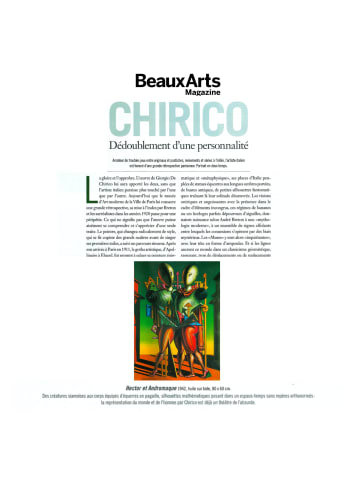At the Museum of Modern Art of the City of Paris. Giorgio De Chirico: Geometer of the Absurd
Glory and disgrace. The work of Giorgio de Chirico brought him both, without the Italian artist seeming more affected by one than the other. Now that the Museum of Modern Art of the City of Paris is dedicating a major retrospective to him, his blacklisting by Breton and the Surrealists in the 1920s appears to be a mere episode. This does not mean, however, that the work can be easily understood and appreciated all at once. The painter, who radically changed his style, who became a copyist of the great masters before parodying his first canvases, followed a winding path.
After his arrival in Paris in 1911, the artistic elite, from Apollinaire to Éluard, was quick to hail his enigmatic and “metaphysical” painting, his Italian squares populated by equestrian statues with long shadows, antique busts, and small ghostly silhouettes dragging along their idle solitude. These dreamlike and anxious visions, featuring incongruous elements such as bunches of bananas or clocks sometimes without hands, gave birth, according to André Breton, to a “modern mythology,” a set of alarming signs among which connections are made through mysterious means. The “Muses” are thus “disturbing,” with heads shaped like lightbulbs. And if the lines anchor this world in a reassuring geometric classicism, too many displacements or substitutions blur the order of things. False perspectives and shadows, a yellowish light corresponding to no hour of day or night: in these paintings, seemingly governed by number and order, everything is false and deranged, ultimately belonging to a “skeptical neoclassicism.”
Moreover, man himself is rather insubstantial here. The series “Archaeologists” continues to give rise to half-robotic, half-sculptural creatures, faceless and with the lifeless bodies of the first great mannequins of 1917. These bellies, open onto intricate machinery or filled with architectures, are joined by strange gladiators. Very far from the proud and virile ideal of the new man promoted as a model in the 1920s by fascism, these figures resemble pocket fighters, puppet gladiators with, at best, a small shield and a small lance, but above all an awkward stance. Highly theatrical in its staging, De Chirico’s painting is no less a theater of shadows.
WARHOL LOVES “THE IDEA THAT CHIRICO REPEATS THE SAME PAINTINGS OVER AND OVER”
From 1920 to 1935, he proclaimed himself Pictor optimus (“The best painter”): a return to grand painting, with pompous portraits that exalt materiality and an ostentatious, energetic brushstroke. It is the time when the painter eagerly draws lessons from great academic treatises and becomes a copyist of the great masters: Michelangelo, Titian, Rubens, Fragonard, Watteau, Courbet – the list is not exhaustive – all enter his “imaginary museum” De Chirico trains his hand, rediscovers the classics, becomes classical himself, at the risk of leaving others the paths of modernity: no longer the audacious painter who once saw himself as a visionary of the unconscious, he now borders on the grotesque and seems to enjoy it.
He delivers self-portraits in period costume, “the face evacuated by thought, sheepish and obtuse, beneath a mane of wool-white hair, hands crossed over the protruding belly,” as Julien Gracq uncharitably describes him in En lisant, en écrivant. He casts his wife as Diana the Huntress or Angelica, a character from the Italian poet Ariosto, in baroque paintings with thick, if voluptuous, paint. He paints Venice in small, highly touristic canvases. Yet, by endlessly pastiching the masters or traditional genres, he eventually comes to pastiche himself.
From the 1940s onward, De Chirico copies his metaphysical works while introducing subtle variations: moving a tower, adding some fruit, shifting a statue’s position... He is then reproached for being his own forger, for going in circles, for wanting to sell. Andy Warhol, who was his friend, saw in this a fundamental principle. The American confided to Italian curator Achille Bonito Oliva in 1982, on the occasion of the De Chirico exhibition at MoMA in New York, how much he admired the Italian painter for this “idea that he repeats the same paintings over and over. I love that idea, and I thought it would be great to apply it.” The late Warhol himself did not escape the reproach of producing too many commissioned portraits. But he indeed made De Chirico the inventor of the series, of that idea that a masterpiece need not be unique, that it can be copied, remade almost identically, and exist in two, three, four... up to eighteen (barely) different versions of The Disquieting Muses.
Not content with shifting reality into a parallel world populated by panting, faceless beings, calling himself a “de-paysager” according to Jean Cocteau’s expression, the former avant-garde painter, former academic painter, then painter of series, also moved frequently within his own canvases. The Return of Ulysses, painted ten years before his death, depicts the hero of the Odyssey in a paradoxical epic: in a furnished interior, a large puddle representing the sea, and Ulysses in a boat, rowing. As if, though returned home, he were still elsewhere, facing wind and tide. Perhaps a metaphor for that De Chirico who never ceased returning to himself.”

